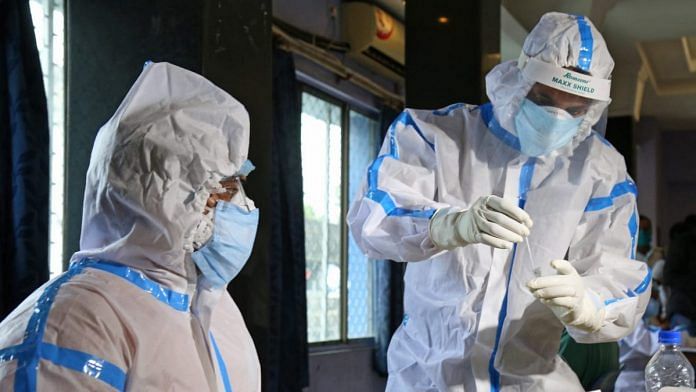
New Delhi: Until vaccines become widely available, weekly Covid-19 testing and two-week isolation is the most cost-effective strategy to control transmission of the virus, a new study in The Lancet has found.
According to a press release by the journal, the modelling study is “the first to identify cost-effective strategies based on local transmission rates, the cost of testing and hospitalisations, and a societal willingness to pay in order to prevent Covid-19 deaths”.
Conducted by researchers in the US and Hong Kong, the study is based on a “multiscale model” that included various dimensions, including the transmission of SARS-CoV-2 at the population level, isolation period and testing frequency.
The model indicated that in places where the virus is spreading rapidly, the most effective strategy is weekly testing and a two-week isolation period after testing positive.
Meanwhile, it also suggested that in places where “non-pharmacological measures” (without medicines) have arrested the spread of the virus effectively, monthly testing with a one-week isolation period “is expected to be the most optimal strategy”.
8 Covid surveillance strategies studied
The modelling study included data on the transmission of the virus at the population level and dynamics of the daily viral load at an individual level to “assess eight surveillance strategies” in the US.
The strategies, “varied by testing frequency (from daily to monthly testing) and isolation period (1 or 2 weeks)”, were then compared to the status quo strategy of symptom-based testing and isolation.
The costs for each strategy — which included the costs of the tests, admission to the hospital and “salary lost while in isolation” — and their economic burden, which was quantified through years of life lost (YLL), were estimated. YLL estimates the years of potential life lost due to premature deaths..
“We then assessed the testing strategies across a range of scenarios, each defined by effective reproduction number (Re), willingness to pay per YLL averted, and cost of a test, to estimate the probability that a particular strategy had the greatest net benefit,” the researchers stated in the study.
‘Costs and YLL increase with frequency of testing’
Through the model, the researchers managed to estimate the health outcomes and economic outcome associated with each testing strategy.
“As expected, both costs and YLL averted tend to increase with the frequency of testing and the length of isolation period,” the study found.
“Weekly testing combined with 2-week isolation remains the preferred strategy under high transmission scenarios for larger population sizes if individuals are assumed to resume testing 30 days after a positive test,” it added.
The most costly strategy was daily testing with a two-week isolation period.
The study, however, acknowledged that the optimal strategies it has identified may not be logistically feasible everywhere.
“They require large quantities of low-cost rapid SARS-CoV-2 antigen tests and multifaceted distribution plans that potentially combine school, university, and workplace testing; delivery of home test kits; and widely accessible public testing sites,” it stated.
Subscribe to our channels on YouTube & Telegram
Why news media is in crisis & How you can fix it
India needs free, fair, non-hyphenated and questioning journalism even more as it faces multiple crises.
But the news media is in a crisis of its own. There have been brutal layoffs and pay-cuts. The best of journalism is shrinking, yielding to crude prime-time spectacle.
ThePrint has the finest young reporters, columnists and editors working for it. Sustaining journalism of this quality needs smart and thinking people like you to pay for it. Whether you live in India or overseas, you can do it here.